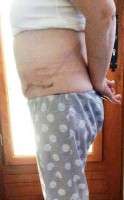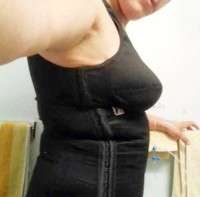Tummy tuck recovery blog
Recovery from a tummy tuck generally takes 6-8 weeks. Immediately after surgery, I advise my patients to sleep on a recliner or with their head up on several pillows. I also recommend walking regularly and with a slightly flexed posture for the first few days. The purpose is to prevent blood clots and to avoid tension on the incision, respectively. My patients are placed on an oral narcotic and an antibiotic to prevent infection.
Pain is present, especially in the first few days, but improves with time. The tummy tuck drains are removed after the first 7-10 days depending on how much fluid is coming out through the drains. I use an abdominal binder the first week and then switch to a compression garment for six weeks to aid with swelling. My patients are encouraged to have lymphatic massages after tummy tuck surgery, especially to areas of liposuction. I then see the patient every 1-2 weeks until the 6-8 week period when pictures are taken. After that, the patient is seen every 6-8 weeks. (Moises Salama, MD, Miami Plastic Surgeon)
What you can learn on tummy tuck recovery blog
Tummy tucks is a big surgery and there is a very high satisfaction rate. However, you do have to budget time for the recovery. Many patients go home the same day but you can also plan on staying overnight. Walking is very important, however, you will need to keep your hips flexed (like you have a cane or are skiing).
Over the next week or so, you slowly straighten up. In addition, you should sleep with pillows under the legs or in a recliner position. Pain control can be managed with narcotics and a pain pump can also help with the post-operative recovery.
Going back to work, if you have a desk job, then I would wait until you are off narcotics during the day time so you can drive back and forth safely. You can definitely take tylenol or ibuprofen for pain control during the day.
If you have job where you travel a lot or lift things, then I would budget more time off of work or make accommodations for lighter duty (e.g. no lifting > 20 lbs for 4 weeks).
During the first 4-6 weeks, you will need some sort of abdominal compression. Most people find it comforting to have this compression and it helps reduce the post-operative tummy tuck swelling.
A tummy tuck is a big decision, so make sure you budget your post-recovery accordingly to make things less hectic at home or at work. (Young R. Cho, MD, PhD, Houston Plastic Surgeon)
The pain of a tummy tuck will vary from one patient to the next and will be a bit more if the muscles are tightened, a common part of the procedure. Most patients are feeling the worst is over after the first 3 days and are getting back into normal activities in about 10-14 days. However vigorous activities will probably not be comfortable for 6-8 weeks. (Ronald V. DeMars, MD, Portland Plastic Surgeon)
Recovery will vary from person to person based on the exact nature of the procedure and how well the patient heals. I typically recommend for my patients to take two weeks off from work and an additional four weeks minimum from strenuous exercise. Most patient will remain a little tired for up to six weeks. (Christine Sullivan, MD, Columbus Plastic Surgeon)
Recovery from tummy tuck varies from patient to patient. Most of my patients take pain medication about 1-2 weeks. You should be able to ambulate on the same day of the surgery or the next day with your waist flexed. You will gradually gain your strength and mobility in 2-3 weeks. However, a heavy exercise (lifting, straining, sit-ups) should be avoided for 6 weeks. (Sugene Kim, MD, Houston Plastic Surgeon)
The early stage phase of healing from a tummy tuck is within 10-14 days where most of the pain, discomfort and limitation in activity occurs. After this period patients slowly return to their daily activities, including light jobs, driving, etc. Of course within the following 4-6 weeks the residual swelling will resolve and the scars will continue to fade for up to one year. Patients vary with regard to pain threshold but most do not require medication after 10 days. You surgeon will examine you periodically to assess your progress and readiness to advance your activities as well as your longterm healing of the scars. Please note that tummy tucks are often combined with liposuction and breast surgery and thus healing patters vary accordingly. That being said if you are adequatley prepared for the recovery phase you will feel is it easier than expected. (Pedy Ganchi, MD, Ridgewood Plastic Surgeon)
The surgery takes 3 hours or more and if you’re having the procedure as an outpatient, you’ll be able to go home shortly thereafter. There is a special technique -a pain pump – that speeds up the recovery and minimizes postoperative discomfort by releasing pain medication in the abdomen during the first few days after surgery. You should ask your doctor if they use this because it can make a big difference in the speed and ease of recovery.
My patients generally return to work in two weeks. Note that you may walk and sit a little hunched over for a few days after the operation. Don’t even try to stand up straight during this time—you risk separating the incisions. Also, you should minimize the strenuousness or suddenness of such exertions as coughing, sneezing, and laughing. (Michelle Copeland, MD, DMD, New York Plastic Surgeon)
Tummy tucks can vary tremendously in their extent ranging from 1 hour to 5 hour procedures and from mini to full. Accordingly the recoveries will vary as well.
We typically see patients at 3-5 days, 10 days, 3 weeks, & 3 months. Most patients return to non-strenous activity at 2 weeks and unrestricted activity at 6 weeks. (Otto Joseph Placik, MD, Chicago Plastic Surgeon)
As several surgeons have pointed out, the recovery varies from patient to patient because not all patients bounce back as quickly and not all tummy tucks are the same.
Three factors to consider are 1) extent of skin/fat excision, 2) need for muscle tightening, and 3) ancillary procedures such as liposuction or breast surgery. Clearly a longer operation will slow you down longer. If you have “mini-abdominoplasty” without muscle tightening you will rebound a lot faster than a traditional tummy tuck.
You may or may not have an overnight stay. I use drains, but some surgeons do not. My patients are seen 4-7 days postop to remove a drain. They wear a garment 23 hours a day and may have silicone pads in place over liposuctioned areas. I prescribe narcotic pain pills and muscle relaxants to help with postoperative pain.
Some patients elect to purchase the On-Q pain ball that drips local anesthesia under the skin and muscles for postop pain relief. Some patients have a much higher pain tolerance and can get off their meds after a few days, but in most cases it takes 1-2 weeks.
Restrictions that I give my patients are: 1) no driving while using the pain pills, 2) no heavy lifting (>10lbs) for 6 weeks, and 3) no vigorous core work for at least 8 weeks, preferably longer.
Most patients can get back to work in 10-14 days, sooner for smaller procedures. You definitely need to have some family or friend support to help around the house and help take care of young children as you will not be able to lift them.
It can take several weeks to several months to feel completely “normal.” Just remember that the healing process is just that, a process. The incisions will be swollen, tight, itchy, and red. Over time, the tightness will resolve and the scar will soften and fade.
Make sure you spend time asking enough questions about your recovery with your board certified plastic surgeon. (Matthew H. Steele, MD, Fort Worth Plastic Surgeon)











